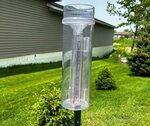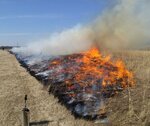

As I look outside on this early June morning, I can tell it’s going to be another dry, hot, and humid day. A few weeks earlier, I observed 1.38 inches of rainfall in a short time frame at my home a few miles south of Faribault, while our office located on the north side of Faribault received a measly .03 inches. As a result, it had been too wet to plant in my portion of the county, but I delivered our Great Plains No-Till drill to a landowner northwest of Faribault who planted soybeans with it that day. It appears the weather has been more sporadic than usual this year, with most events not being county-wide soakers.
The MN DNR State Climatology office records precipitation events throughout the counties in Minnesota in order to track weather trends, provide present and past climate data and conditions, and provide information for wetland delineations. The MN DNR State Climatology office relies on precipitation observers throughout each county to record and track precipitation and weather events from April through October.
Precipitation observers are required to document rain and snow totals on a daily basis. They record 24-hour rain, melted snow amounts, unmelted snow amounts, and snow on-ground amounts. They also have the opportunity to write down comments regarding each precipitation event.
Observers are provided with a cylinder/test tube rain gauge in order to make sure all rain gauges measure the same. The rain gauge comes with useful instructions on where to place the gauge for the most accurate measurements.
There are currently 1439 precipitation observers statewide, with fifteen of them measuring precipitation in Rice County. There is one observer in Richland TWP, two in Walcott TWP, one in Morristown TWP, zero in Wheeling TWP, two in Cannon City TWP, one in Wells TWP, one in Shieldsville TWP, two in Northfield TWP, zero in Bridgewater TWP, two in Forest TWP, one in Erin TWP, one in Webster TWP, and one in Wheatland TWP. These fifteen precipitation observers are critical in providing data through precipitation measurements and documentation that help the MN DNR State Climatology Office track Minnesota’s sporadic weather patterns and are greatly appreciated.
Monitoring precipitation and other weather factors such as wind are important as you farm in the field or work on conservation projects. Checking the wind direction, speed, and forecasted precipitation can help reduce herbicide drift when spraying and ensure optimal success. If you have planted trees this past spring, your seedlings should be watered during the first year, especially if we experience weeks without precipitation. Be sure to check wind conditions, burn restrictions, and fire danger as you plan out controlled burns on prairies or pastures.
Here at the Rice SWCD, we have developed a new webpage that highlights information about precipitation, wind, drought conditions, and burn restrictions for Rice County. Check it out at https://www.riceswcd.org/climate-resourses.
Anyone who is interested in learning more about Minnesota’s weather patterns, precipitation, temperatures, or significant weather events can visit https://climateapps.dnr.state.mn.us/index.htm. If you are interested in becoming a precipitation observer in Rice County, contact Rice SWCD at 507-332-5408. The more observers we have throughout the county, the more accurately we can measure precipitation events and weather patterns.